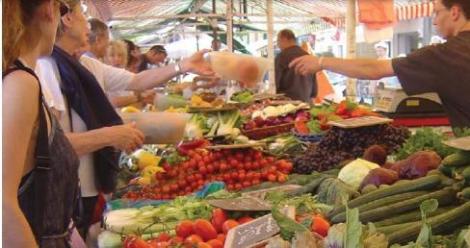Public policies promoting cooperation: the Territorial Food Project
2022
Territorial food projects (PATs) aim to relocalise agriculture and food in local areas by supporting the establishment of farmers, short supply chains and local products in canteens. Stemming from the 2014 Law on the Future of Agriculture, which has encouraged their development since 2014, they are developed collectively on the initiative of local stakeholders (local authorities, agricultural and agri-food businesses, artisans, citizens, etc.).
To download : poster_ademe-questcequn_pat.pdf (220 KiB)

PATs embrace a systemic vision of agriculture and food in their region. Based on an assessment of the current situation in the consumption and production basin, regional stakeholders develop a joint project that is translated into an action programme. This makes it possible to coordinate local initiatives to address the challenges identified. Since 2017, these regional projects have been eligible for state certification when they meet the objectives of the National Food Programme (PNA) (2). The PNA identifies six areas of action, which are addressed in varying ways within the projects: food economy, culture and gastronomy, nutrition and health, social accessibility, environment, and urban planning and land use. This certification provides organisations with visibility and, in some cases, financial support from the State or the Region. Not all PATs choose to seek certification. The PAT is a cooperation tool defined by the 2014 Law on the Future of Agriculture, Food and Forestry: ‘Territorial food projects […] are developed in consultation with all stakeholders in a territory and meet the objective of structuring the agricultural economy and implementing a territorial food system’ (3). This leads to the establishment of cooperative practices that bring together a variety of stakeholders, depending on the territory and the mobilisation of its structures. The Regional Directorate for Food, Agriculture and Forestry (DRAAF), which awards the labels, lists 35 PATs in Nouvelle-Aquitaine in 2023. It should be noted that 13 other PATs are being rolled out in the region but have not opted for certification. Since 2020, there have been two levels of PAT:
Level 1, ‘emerging’ PAT: a collective project under development that meets the objectives of the PAT as defined by law. The Level 1 label is valid for three years and is not renewable. At the end of this period, if the PAT wishes to retain the label, it must apply for Level 2.
Level 2, ‘operational’ PAT: a project that enables the implementation of actions led by an established governance structure.
The concept of systems is increasingly associated with food and agricultural transitions in the literature. The ‘food system’ is the way in which ‘people organise themselves in space and time to obtain and consume their food’ (Malassis, 1994) (4). The PAT exists to support the local food system with the aim of promoting the consumption of healthy, local and sustainable food, building on existing resources: land, population, institutions, organisational structures at different levels, public and private economic activities, etc. The State supports the engineering of the PAT-awarded territories in the PNA, thereby bringing together all the actors that make up this food system. This is an essential condition for collective territorial action.
The four challenges of the PAT
Four challenges structure the deployment of a territorial project to move from action to implementation:
1. Identify the stakeholders to be included in the project. This requires a good knowledge of the territory and the actors that make it up.
2. Propose a framework within which the approach will enable the actors to be brought together around a common project and shared ambition to respond to the specific challenges of the territory.
3. Organise and facilitate project governance: Who decides? Who is involved? Who does what? How are actions coordinated? How is communication organised (internally and externally)?
4. Implement actions and evaluate them with the various stakeholders: governance members, implementers, beneficiaries, residents, etc.
The Nouvelle Aquitaine region is brimming with initiatives on different scales that contribute to achieving the objectives of the ‘Food Pact’. These initiatives are organised by local actors to address one or more agricultural and/or food-related issues in a given area. Here are a few examples: developing local food chains and distribution networks, preserving land and setting up and transferring agricultural activities, social justice and food for all, protecting the environment (water resources and biodiversity), shared governance, citizen participation, introducing organic and sustainable products into collective catering, promoting healthy eating, raising awareness about food, etc. PQN-A listed 49 such initiatives in its Directory of Local Food Initiatives in August 2023. To complete this overview, L’Essaimeur has compiled an interactive map of food initiatives and approaches in Nouvelle-Aquitaine. These include PATs and third places for food.